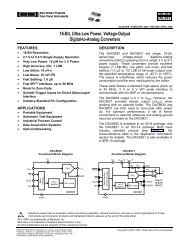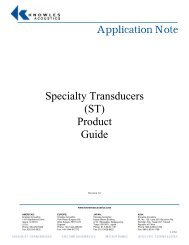AD7714* 3 V/5 V, CMOS, 500 µA Signal Conditioning ADC - dreamm
AD7714* 3 V/5 V, CMOS, 500 µA Signal Conditioning ADC - dreamm
AD7714* 3 V/5 V, CMOS, 500 µA Signal Conditioning ADC - dreamm
You also want an ePaper? Increase the reach of your titles
YUMPU automatically turns print PDFs into web optimized ePapers that Google loves.
AD7714<br />
Filter Registers. Power On/Reset Status: Filter High Register: 01 Hex. Filter Low Register: 40 Hex.<br />
There are two 8-bit Filter Registers on the AD7714 from which data can either be read or to which data can be written. Tables IX<br />
and X outline the bit designations for the Filter Registers.<br />
Table IX. Filter High Register (RS2–RS0 = 0, 1, 0)<br />
B/U WL BST ZERO FS11 FS10 FS9 FS8<br />
Table X. Filter Low Register (RS2-RS0 = 0, 1, 1)<br />
2<br />
FS7 FS6 FS5 FS4 FS3 FS2 FS1 FS0<br />
B/U<br />
WL<br />
BST<br />
ZERO<br />
FS11 - FS0<br />
Bipolar/Unipolar Operation. A 0 in this bit selects Bipolar Operation. This is the default (Power-On or RESET)<br />
status of this bit. A 1 in this bit selects unipolar operation.<br />
Word Length. A 0 in this bit selects 16-bit word length when reading from the data register (i.e., DRDY returns<br />
high after 16 serial clock cycles in the read operation). This is the default (Power-On or RESET) status of this<br />
bit. A 1 in this bit selects 24-bit word length.<br />
Current Boost. A 0 in this bit reduces the current taken by the analog front end. When the part is operated with<br />
f CLK IN = 1 MHz or at gains of 1 to 4 with f CLK IN = 2.4576 MHz, this bit should be 0 to reduce the current<br />
drawn from AV DD , although the device will operate just as well with this bit at a 1. When the AD7714 is operated<br />
at gains of 8 to 128 with f CLK IN = 2.4576 MHz, this bit must be 1 to ensure correct operation of the<br />
device. The Power-On or RESET status of this bit is 0.<br />
To ensure correct operation of the part, a 0 must be written to this bit.<br />
Filter Selection. The on-chip digital filter provides a Sinc 3 (or (Sinx/x) 3 ) filter response. The 12 bits of data<br />
programmed into these bits determine the filter cut-off frequency, the position of the first notch of the filter and<br />
the data rate for the part. In association with the gain selection, it also determines the output noise (and hence<br />
the effective resolution) of the device.<br />
The first notch of the filter occurs at a frequency determined by the relationship:<br />
filter first notch frequency = (f CLK IN /128)/code<br />
where code is the decimal equivalent of the code in bits FS0 to FS11 and is in the range 19 to 4,000. With the<br />
nominal f CLK IN of 2.4576 MHz, this results in a first notch frequency range from 4.8 Hz to 1.01 kHz. To<br />
ensure correct operation of the AD7714, the value of the code loaded to these bits must be within this range.<br />
Failure to do this will result in unspecified operation of the device.<br />
Changing the filter notch frequency, as well as the selected gain, impacts resolution. Tables I through IV show<br />
the effect of the filter notch frequency and gain on the effective resolution of the AD7714. The output data rate<br />
(or effective conversion time) for the device is equal to the frequency selected for the first notch of the filter. For<br />
example, if the first notch of the filter is selected at 50 Hz then a new word is available at a 50 Hz rate or every<br />
20 ms. If the first notch is at 1 kHz, a new word is available every 1 ms.<br />
The settling time of the filter to a full-scale step input change is worst case 4 × 1/(output data rate). For<br />
example, with the first filter notch at 50 Hz, the settling time of the filter to a full-scale step input change is<br />
80 ms max. This settling time can be reduced to 3 × 1/(output data rate) by synchronizing the step input<br />
change to a reset of the digital filter. In other words, if the step input takes place with the SYNC input low or<br />
the FSYNC bit high, the settling time will be 3 × 1/(output data rate) from when SYNC returns high or<br />
FSYNC returns low. If a change of channel takes place, the settling time is 3 × 1/(output data rate) regardless of<br />
the SYNC or FSYNC status as the part issues an internal SYNC command when requested to change channels.<br />
The –3 dB frequency is determined by the programmed first notch frequency according to the relationship:<br />
filter –3dB frequency = 0.262 × filter first notch frequency.<br />
Test Register (RS2-RS0 = 1, 0, 0)<br />
The part contains a Test Register which is used in testing the device. The user is advised not to change the status of any of the bits in this<br />
register from the default (Power-On or RESET) status of all 0s as the part will be placed in one of its test modes and will not operate correctly.<br />
If the part enters one of its test modes, exercising RESET will exit the part from the mode. An alternative scheme for getting the<br />
part out of one of its test modes, is to reset the interface by writing 32 successive 1s to the part and then write all 0s to the Test Register.<br />
REV. B –15–















